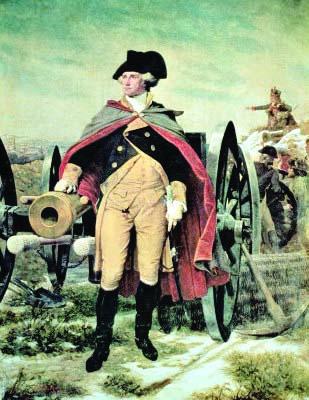February 27, 2019

George Washington at Dorchester Heights by Emanuel Gottlieb Leutze
It’s that time of year again when St. Patrick’s Day—or month—rules the Boston calendar. Too often lost in the shuffle of local revelry are two milestones testifying that the Saint’s day is far more than an opportunity to let the Guinness and song reign.
Whether one calls March 17 “St. Patrick’s Day” or “Evacuation Day,” the Irish can lay claim to both celebrations. Many men bearing surnames of “the old sod” were nestled behind bristling cannons that peered down from Dorchester Heights on that day in 1776. The redcoats, or “Lobsterbacks,” were fleeing Boston aboard Royal Navy vessels straining to haul anchor and hightail it out of the harbor – which lay directly under the Rebels’ heavy guns.
Commanding the Patriots was George Washington, who held a deep regard for Irish-born troops serving in his ranks. He placed such a high estimate upon their proven combat abilities that he honored that most cherished of Irish dates – St. Patrick’s Day – in an era when the Irish and especially Irish Catholics were hardly a favorite of many colonists.
On March 17, 1776, Washington was well aware that it was St. Patrick’s Day and that many Irishmen had fought at Bunker Hill and had just helped drag those cannon up the Dorchester slopes. He acknowledged both facts by ordering that the password of the day be “Saint Patrick.”
Washington also proffered another tip of his tri-cornered hat to Patriots with Irish surnames as the British troops boarded their transports. On that momentous day, he had General John Sullivan countersign the dispatch making “Saint Patrick” the army’s official watchword.
The son of an Irish schoolmaster who had emigrated from Kerry or Limerick to Berwick, Maine, in 1723, Sullivan was one of many Rebels who either hailed from Ireland itself or were the sons of native-born Irish. On St. Patrick’s Day of 1776, as one of Washington’s most trusted officers, Sullivan had long recognized the Rebels’ need for heavy artillery to enforce the siege of Boston. On Dec. 17, 1775, Washington had received a letter from Colonel Henry Knox, a man of Irish lineage who had been sent on a mission to Fort Ticonderoga, in upstate New York. The fortress, taken by Rebel Ethan Allen and his Vermont Green Mountain Boys, contained the heavy artillery so sorely needed by Washington.
According to historian James Bernard Cullen, “[Colonel Knox]…brought, over frozen lakes and almost impassable snows, more than 50 cannons, mortars, and howitzers….Colonel Knox was of a family that originally came from near Belfast…. He was born in Boston, July 25, 1750.”
Washington’s men dragged the artillery up Dorchester Heights and chased the British out of Boston, the Rebels’ feat on March 17 immortalized as Evacuation Day.
One look at the muster rolls of the Continental Army proves the Irish presence on March 17 at Dorchester Heights and throughout the Revolutionary War. They witnessed what their countrymen on the “old sod” could only dream of: the British in full flight. In Boston, March 17 fittingly marks both St. Patrick’s Day and Evacuation Day – the celebration alike of Ireland’s venerated saint and the day the Redcoats departed Boston for good.

